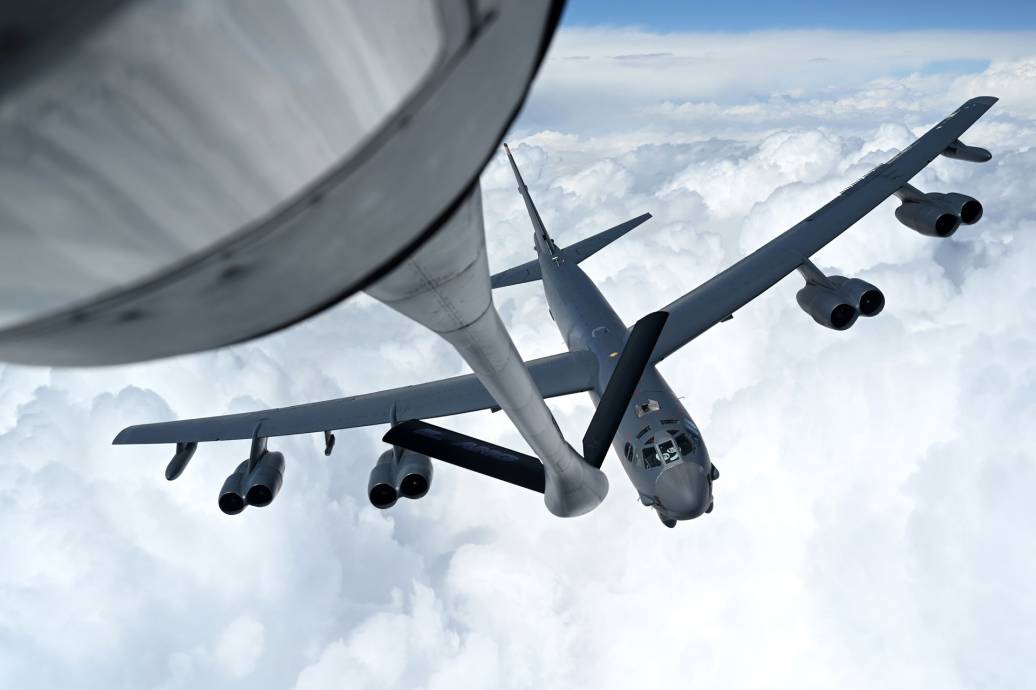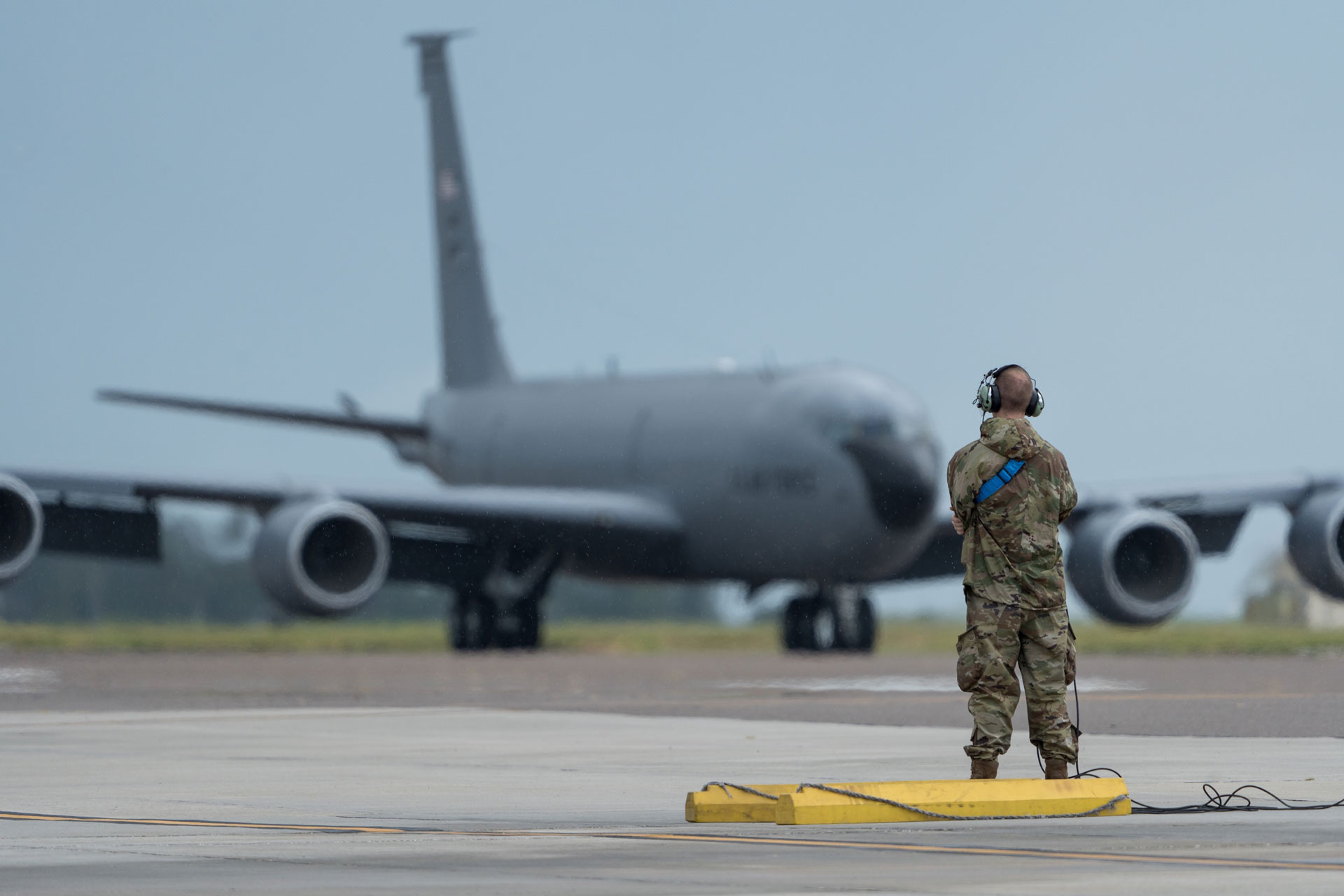

Bob Baxter is CEO of Marshall Aerospace.
Over the past 40 years, he has led business growth initiatives for several multinational aerospace and defence industry leaders including GEC Marconi, Raytheon, BAE SYSTEMS, Leonardo and Thales.
Baxter is also a Senior Research Fellow in Defence at Exeter University.
In 1965, US Air Force General Curtis E LeMay testified to Congress, “I am afraid the B-52 is going to fall apart on us before we can get a replacement for it. There is a serious danger this may happen.”
Armed with hindsight, it is easy to deride LeMay’s predictions about a legendary aircraft that is still in service today. However, the underlying concerns he raised were, in some ways, prescient.
There is still no direct replacement in sight for the B-52, which is now scheduled to remain operational past the hundred-year mark and into the 2050s. The platform is being kept alive through extensive modernisation programmes, rigorous maintenance, cannibalisation of older airframes and judicious management of flying hours. On balance, this may be more cost-effective than procuring a successor, but you could hardly call it cheap.
General LeMay’s key insight, expressed sixty years ago amidst the frenzy of procurement at the height of the Cold War, was that the effectiveness of a platform would ultimately be determined over decades in the maintenance hangars, rather than on the drawing board or production line.
This has proved largely true. Across NATO and allied forces, fixed-wing fleets are now routinely remaining in service for 40, 50, even 60 years; in many cases far surpassing their original design intent. From fast jets to airlifters, the longer an aircraft type is kept in service, the more vexing, unusual and numerous its sustainment issues become.
As we enter an uncharted era of increasingly long-lived fleets, operators will need to draw boundaries around their own responsibilities and forge new partnerships with platform specialists to ensure continuous capability.
Is the B-52 the exception, or the rule?
The B-52 may be the most recognisable case of a platform whose longevity has far outstripped initial projections, but it nonetheless demonstrates an increasingly visible trend of governments choosing to maximise the in-service life of their assets, rather than replacing them.
The UK Royal Air Force, for example, recently extended the out-of-service date of its F-35 Lightning II fleet by a full 21 years, from 2048 to 2069. Similarly, last year the US government passed legislation specifically preventing the proposed retirement of a number of F-15E and F-22 aircraft, and requiring the USAF to maintain an E-3 AWACS fleet to prevent a gap in capability.
These are just a few examples within a much longer list of platforms whose original retirement dates have been extended multiple times, with notable examples being the Tornado, KC-135 Stratotanker, P-3 Orion, U-2 Dragon Lady, Mirage 2000, and, of course, the venerable C-130 Hercules.
Sometimes these decisions are made for broadly positive reasons: certain well-engineered airframes have had their initial service life estimates revised upwards or have proved particularly easy and cost-effective to upgrade continuously.
In other cases, governments have stuck with existing fleets due to fiscal constraints, underperformance of potential replacements, or wariness around committing to a new platform that might itself be rendered obsolete by technological advances a few years down the line.
Whatever the causes, there is no escaping the fact than an aircraft that achieves initial operational capability tomorrow may not leave service until 2070 or beyond. Some of the people who will fly or maintain that aircraft have not even been born yet.
The curse of living longer
At first glance, the notion that a new aircraft will remain airworthy for 50 or even 100 years is largely a good thing. It should provide decades of forward visibility around procurement; it should enable long-term investments in training and platform familiarity; and it should allow flexible decision-making around incremental mid-life upgrades.
Unfortunately, these rosy expectations come up against a few thorny realities.
The first reality is cost. A 2022 report from the United States Government Accountability Office estimated that operating and support expenses now account for approximately 70 percent of the total lifecycle cost of a military aircraft. Speaking from personal experience, that percentage could be even higher, depending on the platform and operator.
This trend will only accelerate as longer in-service periods lead to more maintenance, skewing the cost structure of an aircraft even further in favour of the “long tail” of sustainment.
Ultimately, continuing to invest in maintenance without a clear understanding of a platform’s remaining service potential risks diverting funds from more impactful capability options.
The second reality is availability. Armed forces are expected to keep a certain proportion of airframes constantly mission-ready, but this is a tall order at the best of times. While some aircraft have adapted well through upgrades and modification cycles, most are now entering a phase where structural fatigue, parts scarcity, and system obsolescence introduce accelerating cost and readiness risk.
The same 2022 Government Accountability Office report analysed 49 aircraft types in service with the US armed forces, revealing that more than half did not meet their mission-capable goal in a single year out of the 11 years surveyed. Only four aircraft met their mission-capable goal in a majority of the years in question.
Again, the direction of travel is clear. As an aircraft’s time in service lengthens, inspections are increasingly likely to reveal emergent issues, such as corrosion and fatigue, requiring weeks or months of rectification work. Similarly, acquiring a replacement part or component presents an unenviable choice: wait out the production lead time (potentially years long), brave the secondary market, or cannibalise another airframe. None of this is good news from a fleet availability standpoint.
At the same time, prematurely retiring a platform without substantiating data may reduce force availability and mission flexibility. We work with customers who walk this tightrope every day.
The third reality is airworthiness and through-life capability. For each aircraft type in service, it is necessary to track and implement mandatory airworthiness directives and recommended service bulletins, while managing complex approval processes and supply chain challenges for modifications. This is currently handled by fleet operators, and if you multiply this by the number of aircraft types (and variants) they are responsible for, it becomes easy to see why the administrative and technical requirements of airworthiness management can lead to the emergence of bloated, confused organisations perpetually buried under paperwork.
Similarly, mid-life upgrades and new capability insertions present significant integration challenges, such as determining the right timing and sequence for integrating, testing and certifying modern systems across a fleet while maintaining mission-readiness and meeting budget constraints.
None of these observations are meant as a slight on the capabilities of the fleet operators my colleagues and I work with every day. Rather, I am trying to explain how these organisations have very understandably found themselves beleaguered by the numerous new responsibilities, logistical requirements and areas of expertise they are having to take on, with no prospect of additional resources to help them meet their availability requirements.
I have now heard from several operators, and even MRO organisations, who have unflinchingly informed their governments that they do not (and should not be expected to) possess the in-house capabilities to undertake such multifaceted, highly specialised sustainment.
What operators are now asking
Across allied air forces, the same questions are now being asked, quietly, inside program offices, inside budget meetings and increasingly at command levels:
“Can we afford to keep flying these aircraft?”
“Which airframes still merit upgrade investment, and which no longer do?”
“How do we preserve readiness without overspending on declining assets?”
These are capability questions, force availability questions, and, ultimately, questions of strategic posture. Answering them credibly requires structured, platform-level analysis, not assumptions, not averages and not hope.
The challenge is not simply sustaining aircraft longer, but identifying which airframes justify further investment. And without guidance from asset-level data, resources are often misallocated into reactive maintenance and unsustainable spend on platforms with diminishing value, while inadvertently reducing fleet availability where would be most needed.
Envisioning a new role for platform specialists
Against a backdrop of evolving mission demands, greater regulatory scrutiny and tighter defence budgets, my advice to operators is to look beyond engaging with MRO providers on a contract-by-contract basis, and instead seek to work with us as partners. Our specialist platform expertise and global networks have already given us the right tools to manage the technical, regulatory, and logistical demands of long-lived fleets.
These partnerships should be centred around through-life management—a strategic framework that aligns sustainment with operational needs at every stage of an aircraft's life. As platform age increases, so do the risks to safety, availability, and cost-effectiveness—necessitating a data-driven assessment to inform future force planning.
Rather than reactive maintenance, through-life management enables proactive inspection regimes, mid-life upgrades, training programmes, fatigue monitoring, life-extension programmes, and supply chain management to ensure maximum value, operational availability and safety across potentially decades of demanding service. We can provide this as a clear decision-support tool: a fleet-wide condition map, prioritised investment guidance, and a validated basis for platform retention, phased withdrawal, or replacement.
This is an ideal role for platform specialists like Marshall Aerospace. Having supported a global customer base for decades, we maintain dedicated teams with deep technical knowledge spanning every part of the military aircraft lifecycle, from entry into service through to eventual disposal and resale. Unlike operators who must balance numerous priorities across multiple platforms, we can focus exclusively on through-life sustainment, ensuring a level of attention and specialisation that would be difficult to achieve internally.
Through-life decisions cannot rest on guesswork or inertia, given their enormous strategic, operational and financial consequences. A structured aircraft-level assessment allows operators to take control: retain what’s viable, extend what’s worth it and retire what no longer serves.
Marshall Aerospace through-life assessment
A structured review to evaluate platform condition and determine viability for continued service. Designed for aging fleets under rising cost and readiness pressure.
Delivered outputs:
• Aircraft-level condition scoring
• Life-extension vs retirement decision matrix
• Indicative cost estimates by platform
• Executive summary briefing and prioritised action planClient impact:
• Reduced sunk cost on declining assets
• Extend viable aircraft with confidence
• Free leadership from reactive sustainment cycles
Once operators are able to spare themselves the headache of trying to do everything across every platform, they can concentrate on their core mission while ensuring their aircraft remain capable, compliant, and cost-effective—no matter what the next 50 years throw at them.


